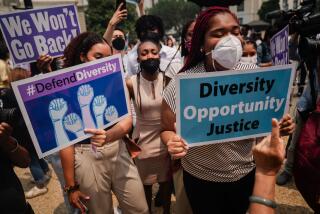Latest UCLA diversity report signals little improvement in Hollywood movies and TV
As Marvel’s “Black Panther” continues to break box office records worldwide in its first two weeks of release, the first superhero blockbuster with a majority black cast has been hailed as a major step forward for diversity and inclusion in Hollywood.
Others might call that merely a good start.
A new study from UCLA makes the case that the industry could still use a boost when it comes to proportional representation of minorities and women on screens large and small.
Moreover, the industry lag in diverse representations may be negatively affecting box office receipts and ratings.
MORE: Read the full UCLA Hollywood Diversity Report »
“Diversity sells, and for the past five years, we’ve seen that all audiences, regardless of race, want to see diversity on-screen,” said Ana-Christina Ramón, who wrote the report with Darnell Hunt. “They prefer movies that have diverse casts, and they prefer to watch TV that has diversity as well.”
UCLA’s “Hollywood Diversity Report 2018,” also co-written by Michael Tran, Amberia Sargent and Debanjan Roychoudhury, is the fifth in an annual series examining relationships between diversity and the bottom line in the entertainment industry. This year’s study evaluated the top 200 theatrical films released in 2016 and 1,251 broadcast, cable and digital platform television shows from the 2015-16 season to document the degree to which women and people of color are present in front of and behind the camera.
Regarding minority representation, since last year’s report (which covered the 2015 film year and the 2014-15 TV season), people of color posted gains relative to their white counterparts in eight of 11 industry employment arenas examined: film directors, film writers, broadcast scripted leads, cable scripted leads, broadcast reality and other leads, cable reality and other leads, digital scripted leads and digital scripted show creators. They lost ground in the area of broadcast scripted show creators and merely sustained representation as film leads and cable scripted show creators.
It’s not a case where people can take their feet off the pedal.
— Ana-Christina Ramón
Overall, people of color remained underrepresented, considering they were 40% of the U.S. population in 2016. A total of 13.9% of the year’s film leads were people of color. On TV, 18.7% of scripted broadcast leads, 20.2% of scripted cable leads and 12.9% of scripted digital leads were people of color.
As for female representation, women gained in all evaluated employment arenas except for film directors, broadcast scripted show leads, cable scripted show creators and broadcast scripted show creators. They fell further behind in the former three arenas and merely held their ground in the latter. Women nabbed 31.2% of film leads, but only 6.9% of the movies surveyed were directed by women and only 13.8% were written by women.
The study also noted that as 2016 brought inclusive films like “Moonlight,” “Hidden Figures” and “Fences” to theaters, minority-directed projects and those with minority leads gained ground at the 2017 Oscars relative to those led by white directors or that featured white leads. That followed two consecutive years of #OscarsSoWhite protests over all-white acting nominees.
Comparatively, films released in 2016 with female leads lost ground at the Academy Awards, while those directed by women failed, for a second year in a row, to win a single Oscar.
On the television front, during a year in which inclusive shows like “Empire,” “Scandal” and “How to Get Away With Murder” were the highest rated across multiple demographics, broadcast scripted shows created by people of color were actually in short supply. Only 7.1% of the creators of broadcast scripted programs were people of color, with a similar 7.3% of cable scripted shows created by people of color. And only 15.7% of digital scripted shows were created by people of color.
This data arrive after a presumed landmark year in film and television — with projects like “Coco,” “Star Wars: The Last Jedi,” “Get Out,” “Master of None” and “This Is Us” — hugely successful and nabbing awards season honors for their diverse talent. And while that could signal better numbers on the horizon, Ramón cautions that what audiences may feel like they’re seeing in terms of an increase in representation doesn’t necessarily manifest when data are evaluated.
“Even though we have these examples [of inclusiveness,] it’s like a psychological thing where you have a handful of examples and so you think there should be a big increase, but that’s not necessarily the case when you look at the whole population [of film and television shows],” she said. “The vast array of movies and television shows out there still aren’t representative, and when you look at the whole picture, the needle isn’t moving that much.”
While television is doing a lot better on the diversity front than film, the UCLA study also evaluated both media in regards to their bottom lines, ratings and box office, respectively. Median 18-49 viewer ratings, as well as median household ratings among black people, Latinos and Asian Americans, were highest during the 2015-16 season for broadcast scripted shows that were greater than 20% minority. For white households, ratings were highest for broadcast scripted shows with casts greater than 40% minority.
Film-wise, pictures with casts that were between 21% and 30% diverse enjoyed the highest median global box office and return on investment. Movies with the most racially and ethnically homogenous casts were the poorest performers on average.
This research falls in line with a study released by the Creative Artists Agency last year which noted that across every budget level, a picture with a diverse cast outperforms a release not as diverse.
Overall, UCLA’s study, taking into account the five years data have been collected and evaluated, presents an image of only slight improvement in representation for women and people of color. Much of that development has centered on black talent, with other communities of color experiencing very little increases.
“It’s not a case where people can take their feet off the pedal,” Ramón said. “They need to keep pushing forward.”
Check out the full study online here.
Get your life! Follow me on Twitter (@TrevellAnderson) or email me: [email protected].
More to Read
Only good movies
Get the Indie Focus newsletter, Mark Olsen's weekly guide to the world of cinema.
You may occasionally receive promotional content from the Los Angeles Times.











